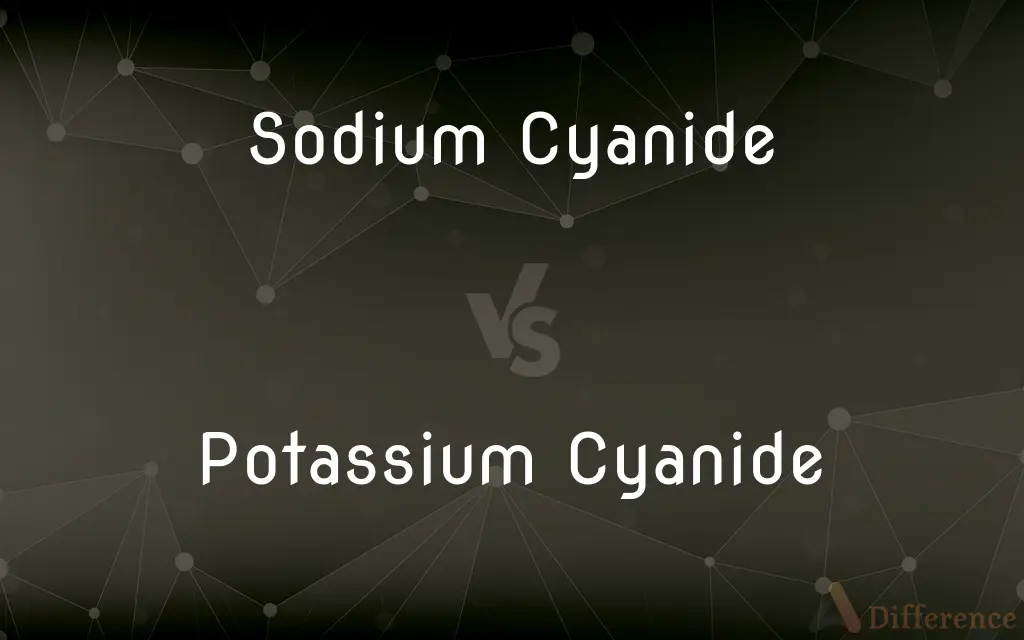Sodium Cyanide vs. Potassium Cyanide — What's the Difference?
By Tayyaba Rehman — Published on November 19, 2023
Sodium cyanide (NaCN) and potassium cyanide (KCN) are both highly toxic cyanide salts, used in mining and synthesis, differing mainly in their cation (sodium vs. potassium) but exhibiting similar properties and applications.

Difference Between Sodium Cyanide and Potassium Cyanide
Table of Contents
ADVERTISEMENT
Key Differences
Sodium cyanide, presenting itself as a white, water-soluble solid, embodies a critical role in the extraction of gold and other precious metals from their ores, leveraging its capability to form strong complexes with gold. Alternatively, potassium cyanide, also a white solid and soluble in water, similarly enjoys application in gold mining and electroplating, underlining the shared utility of these cyanide salts in industrial processes, despite the distinct metallic element they contain.
In an analytical chemistry context, sodium cyanide is often employed to prepare nitriles, which is fundamental in synthetic organic chemistry, pointing towards its embedded significance in facilitating chemical reactions. Diverging slightly, potassium cyanide finds notable use in organic synthesis as well, but also extends its utility to the production of repoussé and chasing tools, highlighting a nuanced differentiation in their applications in chemical and metallic processes respectively.
Sodium cyanide, owing to its hygroscopic nature, can absorb moisture from the air, a property that needs mindful storage considerations to maintain its efficacy and safety in applications. Contrastingly, potassium cyanide, while sharing hygroscopic traits, necessitates its own meticulous storage and handling conditions, considering its lethal implications upon exposure and ingestion, underscoring a collective need for rigorous safety and management protocols for both substances.
Environmental concerns regarding sodium cyanide stem from its usage in gold mining, which, if improperly managed, can result in detrimental impacts on aquatic life and ecosystems due to its high toxicity. In a parallel vein, potassium cyanide also triggers environmental red flags, where mismanagement or accidental releases into ecosystems can wreak havoc on biological entities, putting a spotlight on the critical importance of sustainable practices and safety protocols in handling both cyanides.
Thus, while sodium cyanide and potassium cyanide possess overarching similarities in their toxicological profiles and applications in mining and synthesis, the subtleties of their specific usages, coupled with the inherent distinction in their cationic counterparts, weave a narrative of closely related, yet discretely unique entities, each with its own subset of applications and safety considerations in industrial and chemical contexts.
ADVERTISEMENT
Comparison Chart
Chemical Formula
NaCN
KCN
Common Use
Gold mining
Gold mining and electroplating
Solubility
Highly soluble in water
Highly soluble in water
Application in Synthesis
Used to prepare nitriles
Used in organic synthesis
Safety Management
Requires cautious storage due to hygroscopic nature and toxicity
Requires cautious storage and handling due to toxicity
Compare with Definitions
Sodium Cyanide
Notorious for its high toxicity and environmental impact.
Mishandling of sodium cyanide can lead to severe environmental consequences.
Potassium Cyanide
Implicated in the production of repoussé tools.
Artisans utilize potassium cyanide in producing specific metalworking tools.
Sodium Cyanide
Used synthetically to prepare nitriles.
Chemists employ sodium cyanide in the synthesis of organic nitriles.
Potassium Cyanide
A toxic white solid, utilized in several industrial applications.
Potassium cyanide is commonly used in electroplating processes.
Sodium Cyanide
A hygroscopic chemical necessitating cautious storage.
Sodium cyanide can absorb moisture, demanding careful storage practices.
Potassium Cyanide
Used in various syntheses in organic chemistry.
Potassium cyanide is integral to certain synthetic pathways in laboratories.
Sodium Cyanide
Recognized for its ability to complex with gold.
Sodium cyanide forms stable complexes with gold, facilitating extraction.
Potassium Cyanide
Known for its role in gold mining.
Like sodium cyanide, potassium cyanide is used to extract gold from ores.
Sodium Cyanide
A white, water-soluble solid used in mining.
Sodium cyanide is pivotal for extracting gold from its ores.
Potassium Cyanide
A compound requiring stringent handling due to toxicity.
Extreme caution is mandated when handling potassium cyanide due to its lethality.
Common Curiosities
Are both sodium cyanide and potassium cyanide highly toxic?
Yes, both compounds are highly toxic and require cautious handling.
Is potassium cyanide used in electroplating?
Yes, potassium cyanide is widely utilized in electroplating.
What is the primary use of sodium cyanide?
Sodium cyanide is primarily used in gold mining and chemical synthesis.
Can sodium cyanide absorb moisture from the air?
Yes, sodium cyanide is hygroscopic and can absorb moisture.
Is sodium cyanide used in the production of nitriles?
Yes, sodium cyanide is employed in synthesizing nitriles.
Is it critical to store potassium cyanide securely?
Absolutely, due to its high toxicity, secure storage is paramount.
Can sodium cyanide form stable complexes with metals?
Yes, sodium cyanide forms particularly stable complexes with certain metals like gold.
What physical form does potassium cyanide take at room temperature?
Potassium cyanide is a white, solid compound at room temperature.
What is a commonality between sodium cyanide and potassium cyanide?
Both are utilized in the extraction of gold from ores.
Can sodium cyanide and potassium cyanide be lethal to aquatic life?
Yes, both compounds are extremely toxic to aquatic organisms.
What safety precautions are necessary for handling sodium cyanide?
Utilizing personal protective equipment and adhering to storage guidelines are essential.
Can potassium cyanide be synthesized in the laboratory?
Yes, potassium cyanide can be synthesized, though typically it's commercially procured due to synthesis risk.
Can potassium cyanide be used in organic synthesis?
Yes, potassium cyanide is used in various synthetic processes in organic chemistry.
Are sodium cyanide and potassium cyanide utilized in the chemical industry?
Yes, both are used in various chemical processes, including synthesis and metal extraction.
Are there alternative methods to cyanide for gold extraction?
Yes, alternative methods like gravity concentration and froth flotation are available but may be less effective.
Share Your Discovery

Previous Comparison
Rate of Reaction vs. Rate ConstantNext Comparison
Diet Sprite vs. Sprite ZeroAuthor Spotlight
Written by
Tayyaba RehmanTayyaba Rehman is a distinguished writer, currently serving as a primary contributor to askdifference.com. As a researcher in semantics and etymology, Tayyaba's passion for the complexity of languages and their distinctions has found a perfect home on the platform. Tayyaba delves into the intricacies of language, distinguishing between commonly confused words and phrases, thereby providing clarity for readers worldwide.











































